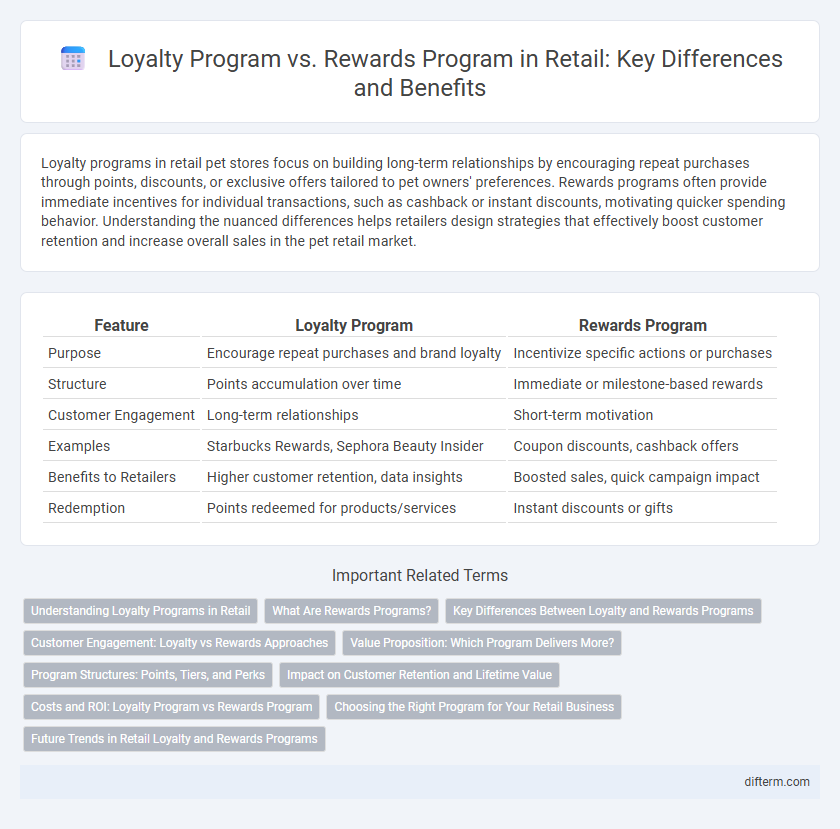Loyalty programs in retail pet stores focus on building long-term relationships by encouraging repeat purchases through points, discounts, or exclusive offers tailored to pet owners' preferences. Rewards programs often provide immediate incentives for individual transactions, such as cashback or instant discounts, motivating quicker spending behavior. Understanding the nuanced differences helps retailers design strategies that effectively boost customer retention and increase overall sales in the pet retail market.
Table of Comparison
| Feature | Loyalty Program | Rewards Program |
|---|---|---|
| Purpose | Encourage repeat purchases and brand loyalty | Incentivize specific actions or purchases |
| Structure | Points accumulation over time | Immediate or milestone-based rewards |
| Customer Engagement | Long-term relationships | Short-term motivation |
| Examples | Starbucks Rewards, Sephora Beauty Insider | Coupon discounts, cashback offers |
| Benefits to Retailers | Higher customer retention, data insights | Boosted sales, quick campaign impact |
| Redemption | Points redeemed for products/services | Instant discounts or gifts |
Understanding Loyalty Programs in Retail
Loyalty programs in retail are designed to foster long-term customer engagement by offering points, discounts, or exclusive benefits that accumulate with each purchase, encouraging repeat business. These programs collect valuable consumer data, allowing retailers to personalize marketing efforts and enhance customer experience effectively. Unlike rewards programs that provide immediate incentives, loyalty programs build sustained relationships by rewarding consistent patronage over time.
What Are Rewards Programs?
Rewards programs are customer engagement strategies designed to incentivize repeat purchases by offering points, discounts, or exclusive benefits for each transaction. These programs track customer spending to accumulate rewards that can be redeemed for products, services, or special offers, fostering long-term brand loyalty. In retail, effective rewards programs leverage data analytics to personalize incentives, enhancing customer satisfaction and increasing sales frequency.
Key Differences Between Loyalty and Rewards Programs
Loyalty programs primarily focus on building long-term customer retention by offering points or exclusive benefits based on cumulative purchases, whereas rewards programs emphasize immediate incentives or discounts to encourage quick sales. Loyalty programs track and analyze customer behavior over time to personalize offers and foster brand allegiance, while rewards programs aim to boost short-term engagement and repeat transactions with instant gratification. The key difference lies in the strategy: loyalty programs invest in sustained customer relationships, and rewards programs drive frequent, impulsive buying.
Customer Engagement: Loyalty vs Rewards Approaches
Loyalty programs focus on building long-term customer relationships by offering tiered benefits and exclusive perks that encourage repeat purchases and brand advocacy. Rewards programs emphasize immediate incentives, such as discounts or points, to drive short-term sales and quick customer engagement. Combining both approaches can maximize customer retention and enhance overall shopping experience in the retail sector.
Value Proposition: Which Program Delivers More?
Loyalty programs deliver sustained value by fostering long-term customer engagement through personalized offers and exclusive benefits, increasing customer lifetime value and brand affinity. Rewards programs provide immediate gratification with point-based incentives, encouraging frequent purchases but often lacking emotional connection and retention power. Retailers seeking to maximize customer loyalty and profitability find comprehensive loyalty programs more effective in driving consistent repeat business and higher average order values.
Program Structures: Points, Tiers, and Perks
Loyalty programs typically feature tiered structures that reward customers based on accumulated points, encouraging long-term engagement through escalating perks and exclusive benefits. Rewards programs often offer immediate, straightforward incentives such as discounts or freebies without complex tier progression, focusing on instant gratification. Effective program design in retail balances points accrual, tier advancement, and diverse perks to maximize customer retention and increase lifetime value.
Impact on Customer Retention and Lifetime Value
Loyalty programs foster long-term customer retention by encouraging repeat purchases through point accumulation and exclusive benefits, directly increasing customer lifetime value (CLV). Rewards programs, while also incentivizing spending, often focus on immediate gratification and may drive short-term sales spikes rather than sustained engagement. Retailers leveraging loyalty programs report higher CLV as customers develop brand affinity and spend progressively over time.
Costs and ROI: Loyalty Program vs Rewards Program
Loyalty programs typically involve higher upfront costs due to personalized customer engagement and data analytics investments, while rewards programs often focus on direct discounts and incentives with lower initial expenses. The ROI of loyalty programs can be greater over time as they foster long-term customer retention and increase lifetime value, whereas rewards programs may yield quicker but less sustained returns by driving short-term sales spikes. Retailers must evaluate cost structures and customer behavior to determine which program maximizes profitability and customer loyalty.
Choosing the Right Program for Your Retail Business
Choosing the right program for your retail business depends on customer engagement goals and purchasing behavior; loyalty programs focus on long-term relationship building by awarding points for repeat purchases, while rewards programs offer immediate incentives for specific actions or transactions. Analyze customer data to determine which program better drives retention and increases average order value, tailoring the strategy to your brand's unique market position. Implementing an integrated CRM system can optimize program performance by tracking customer interactions and personalizing offers to maximize ROI.
Future Trends in Retail Loyalty and Rewards Programs
Retail loyalty programs are evolving to integrate AI-driven personalization and blockchain technology, enhancing customer data security and tailored rewards. Omnichannel engagement strategies are increasingly adopted, allowing seamless customer experiences across physical and digital touchpoints. Future trends emphasize sustainability rewards and real-time analytics to boost customer retention and brand loyalty.
Loyalty Program vs Rewards Program Infographic

 difterm.com
difterm.com